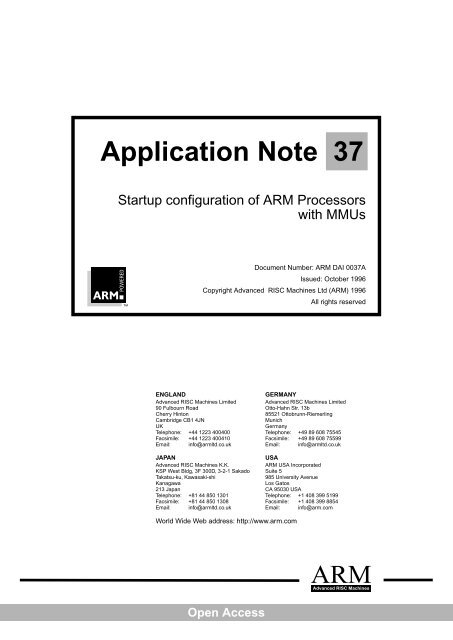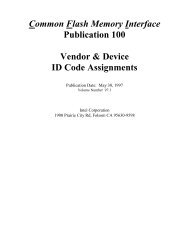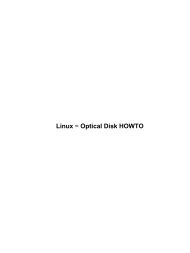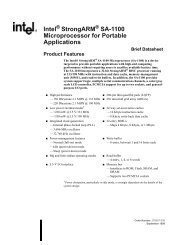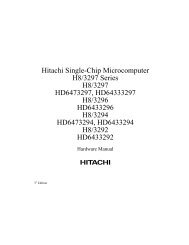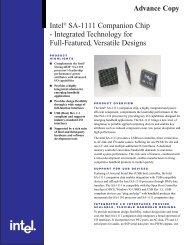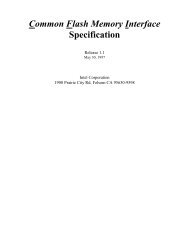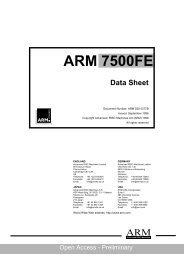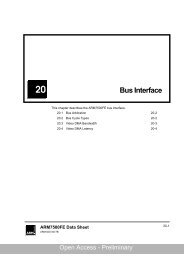Application Note 37 - RPMfind.net
Application Note 37 - RPMfind.net
Application Note 37 - RPMfind.net
You also want an ePaper? Increase the reach of your titles
YUMPU automatically turns print PDFs into web optimized ePapers that Google loves.
<strong>Application</strong> <strong>Note</strong> <strong>37</strong>Startup configuration of ARM Processorswith MMUsDocument Number: ARM DAI 00<strong>37</strong>AIssued: October 1996Copyright Advanced RISC Machines Ltd (ARM) 1996All rights reservedENGLANDAdvanced RISC Machines Limited90 Fulbourn RoadCherry HintonCambridge CB1 4JNUKTelephone: +44 1223 400400Facsimile: +44 1223 400410Email: info@armltd.co.ukJAPANAdvanced RISC Machines K.K.KSP West Bldg, 3F 300D, 3-2-1 SakadoTakatsu-ku, Kawasaki-shiKanagawa213 JapanTelephone: +81 44 850 1301Facsimile: +81 44 850 1308Email: info@armltd.co.ukGERMANYAdvanced RISC Machines LimitedOtto-Hahn Str. 13b85521 Ottobrunn-RiemerlingMunichGermanyTelephone: +49 89 608 75545Facsimile: +49 89 608 75599Email: info@armltd.co.ukUSAARM USA IncorporatedSuite 5985 University AvenueLos GatosCA 95030 USATelephone: +1 408 399 5199Facsimile: +1 408 399 8854Email: info@arm.comWorld Wide Web address: http://www.arm.comARMAdvanced RISC MachinesOpen Access
Proprietary NoticeARM, the ARM Powered logo, and EmbeddedICE are trademarks of Advanced RISC Machines Ltd.Windows 95 is a registered trademark of Microsoft Corporation.Windows NT is a trademark of Microsoft Corporation.Neither the whole nor any part of the information contained in, or the product described in, this document may be adapted orreproduced in any material form except with the prior written permission of the copyright holder.The product described in this document is subject to continuous developments and improvements. All particulars of the product andits use contained in this document are given by ARM in good faith. However, all warranties implied or expressed, including but notlimited to implied warranties or merchantability, or fitness for purpose, are excluded.This document is intended only to assist the reader in the use of the product. ARM Ltd shall not be liable for any loss or damagearising from the use of any information in this document, or any error or omission in such information, or any incorrect use of theproduct.KeyDocument NumberThis document has a number which identifies it uniquely. The number is displayed on the front page and at the foot of eachsubsequent page.ARM XXX 0000 X - 00Document StatusThe document’s status is displayed in a banner at the bottom of each page. This describes the document’s confidentiality and itsinformation status.Confidentiality status is one of:(On review drafts only) Two-digit draft numberRelease code in the range A-ZUnique four-digit numberDocument typeARM ConfidentialNamed Partner ConfidentialPartner ConfidentialOpen AccessDistributable to ARM staff and NDA signatories onlyDistributable to the above and to the staff of named partner companies onlyDistributable within ARM and to staff of all partner companiesNo restriction on distributionInformation status is one of:AdvancePreliminaryFinalInformation on a potential productCurrent information on a product under developmentComplete information on a developed productChange LogIssue Date By ChangeA October 1996 JS First releaseii <strong>Application</strong> <strong>Note</strong> <strong>37</strong>Open AccessARM DAI 00<strong>37</strong>A
Table of Contents1 Introduction 42 26-bit and 32-bit configurations 53 Big or little endian configuration 8<strong>Application</strong> <strong>Note</strong> <strong>37</strong>ARM DAI 00<strong>37</strong>A1Open Access
2<strong>Application</strong> <strong>Note</strong> <strong>37</strong>ARM DAI 00<strong>37</strong>AOpen AccessNamed Partner Confidential - Preliminary Draft
Introduction1 IntroductionThe early ARM processors (pre-ARM6) implemented a 26-bit address range andwere little endian only. ARM6 and later ARM cores expanded the address rangeto 32-bits, and provided both little- and big-endian support.This application note examines how the choice of address range and endianismis controlled on ARM processors containing an ARM Memory Management Unit(MMU). This includes all revisions of all ARM 6- and ARM 7-based cachedprocessors:• ARM600• ARM610• ARM700• ARM710• ARM710a• ARM710ac• ARM7100• ARM7500• ARM7500FE.The selection of endianism is also relevant to:• ARM810• StrongARM.<strong>Application</strong> <strong>Note</strong> <strong>37</strong>ARM DAI 00<strong>37</strong>A3Open Access
26-bit and 32-bit configurations2 26-bit and 32-bit configurations2.1 Configuration controlThe first ARM designs implemented a 26-bit address space, a combined programcounter and status register, and limited processor modes for dealing withexceptions. With the ARM6 and ARM7, these changed to a full 32-bit addressspace, separate program counter and status registers, and additional processormodes.To allow the running of operating systems written for earlier 26-bit ARMprocessors, ARM6 and ARM7 offer a 26-bit configuration to allow backwardscompatibility. The recommended operation for new designs is 32-bit configuration.Furthermore, when in a 32-bit configuration, a 26-bit mode may be entered bysoftware for partial emulation of earlier systems.The configuration controls whether a 26 or 32-bit mode is entered upon anexception, and also whether 32-bit modes are available (they are not available in26-bit configuration). In addition, if the core is in a 26-bit mode, but in 32-bitconfiguration, writing to the vector table (addresses 0x0 -> 0x1c) will cause a dataabort (a vector exception). The abort allows a 32-bit OS to intercept 26-bitapplications writing to the vector, to allow veneer code to make a transition fromthe 32-bit mode entry to the 26-bit mode handler, and back again when the handlerreturns.Further details of the 26-bit and 32-bit configurations can be found in ARM<strong>Application</strong> <strong>Note</strong> 11: Differences between the ARM6 Series and Earlier ARMProcessors.The ARM6 and ARM7 cores provide the signals PROG32 and DATA32 to controlwhether the core will start up in 26 or 32-bit configuration. These signals are notpinned out on ARM6 or ARM7 based processors with MMUs, but are insteadcontrolled by coprocessor 15 register 1, bits 4 and 5 respectively.At reset on ARM processors with MMUs, the PROG32 and DATA32 bits in CP15register 1 are set low and place the processor in 26-bit configuration. Because ofthis configuration setting, after reset the processor enters the reset handlerexecuting in 26-bit supervisor mode.Setting the PROG32 and DATA32 bits high will change to 32-bit configuration.However, it will not change the current processor mode, so the processor willcontinue operating in the current 26-bit mode until an explicit mode change iscarried out. In addition, if an exception is generated before an explicit modechange, it will cause a 32-bit mode to be entered but will typically restore the 26-bit mode that was current at the time the exception was generated upon its return.2.2 Changing configuration and modeTo change from a 26-bit configuration to a 32-bit configuration, and change froma 26-bit mode to a 32-bit mode, you must:1 Use an MCR instruction to set bit 4 (PROG32) and bit 5 (DATA32) of CP15register 1.2 Use an MSR instruction to change the CPSR control byte to its standardvalue on reset in 32-bit configuration, which is:4<strong>Application</strong> <strong>Note</strong> <strong>37</strong>ARM DAI 00<strong>37</strong>AOpen AccessNamed Partner Confidential - Preliminary Draft
26-bit and 32-bit configurationsa) I and F bits set to disable interruptsb) Bit 5 clearc) Mode bits equal to 10011, to select SVC32 mode.Thus the necessary startup code to change into 32-bit configuration and 32-bitMOV r14, #0x70; Set PROG32 and DATA32 (and late abort)MCR p15, 0, r14, c1, c0MOV r14, #0xD3; I,F bits set; not Thumb; SVC32 mode.MSR CPSR_c, r14 ; Writes only bits 7:0 of the CPSRThe following points should be noted:2.3 Configuration on future processors• The processor must be in a privileged mode to execute this code.• The machine cannot access a memory location above 64 MBytes beforethis code is executed.• The machine cannot execute code beyond 64 MBytes before this code isexecuted.• Upon reset, the processor will set PROG32 and DATA32 to low,regardless of their previous state. Therefore, this code must always be runby your reset handler.• This code should be run as soon as possible after reset - probably as thefirst thing done in the reset handler. This is to avoid the risk of executinginstructions whose effects differ (sometimes subtly) between 26-bit and32-bit modes, or of entering an exception vector in a 26-bit mode. (Inparticular, do not enable interrupts and do not execute a SWI, anundefined instruction or an instruction that may cause a prefetch or dataabort before running this code.)• On ARM6-based cached processors, this code also selects the late abortmodel. This is done to achieve a startup state consistent with that ofARM7-based cached processors, on which this is the only abort model. Ifyour code is for ARM6-based processors only, and you want to use theearly abort model, replace the initial MOV r14,#0x70 instruction with MOVr14,#0x30.• This code should not be used on processors without an MMU because theMCR instruction will cause an undefined instruction exception to be takenon such processors.ARM810 and StrongARM are different to earlier ARMs because the 26-bitconfiguration is not implemented on these processors. Both are permanently in32-bit configuration, though the 26-bit modes are implemented. However, on reset,the processor will be 32-bit mode (SVC32). Therefore on these processors, nopart of the code described in section 2.2 Changing configuration and mode onpage 5 is needed.Attempting to cause a configuration change on ARM810 or StrongARM by writingto bits 4 or 5 of CP15 reg 1 is simply ignored. These bits are effectively hardwiredto 1, setting 32-bit code and 32-bit data configuration.<strong>Application</strong> <strong>Note</strong> <strong>37</strong>ARM DAI 00<strong>37</strong>A5Open Access
26-bit and 32-bit configurationsTherefore, if the code described above is run on these processors it will no doanything. Code which is intended to run both on the affected processors, and onARM810 or StrongARM, can run the code described in section 2.2 Changingconfiguration and mode on page 5 regardless which processor is being used.2.4 26-bit modes on future ARM coresYou should note that the 26-bit modes also have a limited lifespan. They havealready been dropped completely in the ARM7TDMI core, and they are not likelyto be implemented on any ARM cores subsequent to the ARM8 and StrongARM.The use of these modes is therefore not recommended.<strong>Application</strong> <strong>Note</strong> <strong>37</strong>ARM DAI 00<strong>37</strong>A6Open Access
3 Big or little endian configuration3.1 Endianism control3.2 Configuring endianismBig or little endian configurationThe ARM can treat words in memory as being stored in either little endian or bigendian format. In little endian format, the least significant byte of a word is storedin bits 0-7 of an addressed word. In big endian format, the least significant byte ofa word is stored in bits 24-31 of an addressed word.The ARM core provides signal BIGEND to control whether the core will start up inbig or little endian configuration. This signal is not pinned out on ARM processorswith MMUs, but is instead controlled by coprocessor 15 register 1, bit 7.At reset on ARM processors with MMUs the BIGEND bit in CP15 register 1 is setlow and so places the processor in little endian configuration.<strong>Note</strong>If a little endian system is being used, no further action is required because this isthe default configuration. However, if big endian configuration is required it isnecessary to use an MCR instruction to set bit 7 (BIGEND) of CP15 register 1.Therefore, the startup code to give a 32-bit address space, described in section2.1 Configuration control on page 5, could be modified to cause a change intobig endian configuration as follows:MOV r14, #0xF0; Set BIGEND, PROG32 and DATA32; (and late abort)MCR p15, 0, r14, c1, c0MOV r14, #0xD3; I,F bits set; not Thumb; SVC32 mode.MS CPSR_c, r1 ; Writes only bits 7:0 of the CPSRThis could be simplified on processors that do not implement 26-bit configurations,as only BIGEND then needs setting:MOV r14, #0x80; Set BIGENDMCR p15, 0, r14, c1, c0Again, the code to change the endianism of the processor should be executed assoon as possible after reset, and certainly before any subword-sized memoryaccesses are made.The endianism configuration has no effect on how ARM instructions are fetchedfrom memory, and you should assemble or compile all of the application code(including the startup code) for the endianism that your system will run in once theappropriate selection is made.<strong>Application</strong> <strong>Note</strong> <strong>37</strong>ARM DAI 00<strong>37</strong>A7Open Access
Big or little endian configuration<strong>Application</strong> <strong>Note</strong> <strong>37</strong>ARM DAI 00<strong>37</strong>A8Open Access


